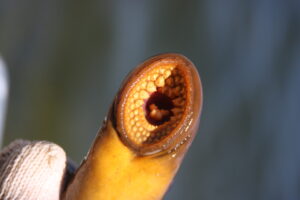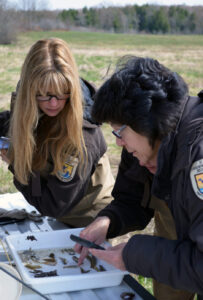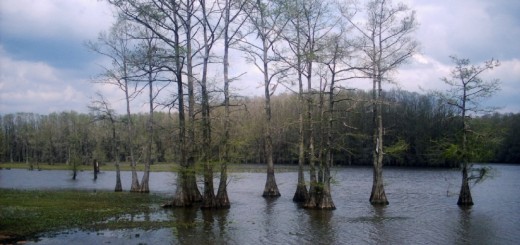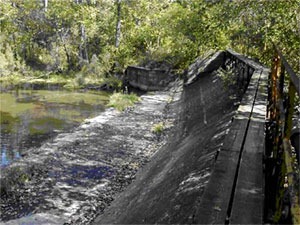Invasive species pose a threat to aquatic ecosystems in how they disrupt fisheries and the natural lake system. Sea lamprey, perhaps one of the most popular and well-known invasive species in the Laurentian Great Lakes, introduces a host of issues. Namely, sea lamprey are considered to be the root of many economic and ecological harms in the Great Lakes.2
The United States and Canada both quickly invested in the management of these invasives early on. The species’ introduction is credited as being one of the causes behind the formation of the bilateral Great Lakes Fishery Commission (GLFC). Thanks to public support and a collaborative approach between the U.S. and Canada, the GLFC was able to reduce sea lamprey by 90% from the peak population.2

Sea Lamprey (Credit: Karla Bartelt / USFWS via Flickr Public Domain)
While the need to control sea lamprey populations is fairly well-established, the methods used are not free of scrutiny. For example, lampricides and barriers have received their fair share of criticism due to potential side effects. Outside of the methods, some oppose the management of non-native species entirely, believing that nature will manage itself. For those reasons, species management plans have been considered controversial as programs often exclude the voices of Indigenous communities who are invested in the health of the fishery.
In order to bridge this gap and holistically incorporate Indigenous knowledge through the creation of an ethical space that equally considers Indigenous and Western approaches to resource management, a 2023 article highlights Two-Eyed Seeing as a potential approach. The article, published in the Journal of Great Lakes Research, explains that Two-Eyed Seeing, or Etuaptmumk, “is a Mi’kmaw framework that encourages the bridging of Indigenous and Western knowledge systems to work together in parallel on a shared issue or problem.”1
The Need for Neutral Space in Management
The article highlights the predominance of Western scientific perspectives in modern management practices and suggests that there may be room for greater inclusion of Indigenous perspectives. This single-perspective approach is the result of the past exclusion of Indigenous voices in decision-making spaces.

The Risk Assessment team: Fish Biologists Cheryl Kaye and Mary Henson inspect non-target mortality to ensure lampricides are effectively targeting sea lamprey with the lowest possible non-target mortality possible (Credit: Joanna Gilkeson / USFWS via Flickr Public Domain)
One of the ways in which this has been done is through policies that govern committees like the Joint Strategic Plan for Management of Great Lakes Fisheries, which requires an organization to have clear fishery management jurisdictional responsibility to be a member of a lake committee–meaning that First Nations were not permitted as voting members.
Two-Eyed Seeing emphasizes the importance of treating different perspectives as parallels for the sake of building public support for stewardship efforts as well as a means for developing a more dynamic understanding of the aquatic systems and surrounding environment from an equally credible source.
Past Success of the Two-Eyed Seeing Approach
Two-Eyed Seeing and other knowledge coexistence approaches have been successful in past projects, one of which was the rehabilitation of Denny’s Dam. The project took place within Saugeen Ojibway Nation (SON) territory and was required as a result of the dam, which was a lamprey barrier, deteriorating. While construction was planned to begin in 2000, failure to communicate with the SON led to substantial delays.
In 2015, a partnership between the SON and GLFC was formed, and the project was finally able to move forward. The knowledge coexistence approach that is included in Two-Eyed Seeing was used to inform and make recommendations for the rehabilitation project.3
From the use of language to the long-standing exclusion of First Nations peoples in decision-making from sea lamprey stewardship, the Two-Eyed Seeing approach invites groups to reassess their current methods. The Two-Eyed Seeing strategy does not claim to place one perspective above the other but emphasizes the importance of equality among stakeholders in the creation of invasive species stewardship.
Sources
- Charity Nonkes, Alexander T. Duncan, Ryan Lauzon, Kathleen Ryan, Andrea J. Reid, Steven J. Cooke, Nathan Young (2023). Two-Eyed Seeing: Developing Perspective and Wisdom on Sea Lamprey in The Laurentian Great Lakes, Journal of Great Lakes Research. https://doi.org/10.1016/j.jglr.2023.03.001.
- Brant, C., 2019. Great Lakes Sea Lamprey: The 70 Year War on a Biological Invader. University of Michigan Press, Ann Arbor, Michigan.
- Ryan, K., 2017. Saugeen Ojibway Nation Environment Office Denny’s Dam Rehabilitation Project Land Use and Occupancy Study Final Report. Saugeen Ojibway Nation Environment Office, 1–69.








[…] For example, some have proposed in response to invasive lamprey in the Great Lakes that the species not be targeted by resource managers using methods like toxins and instead allow the population to be controlled […]
[…] toxin that is lethal to lamprey, preventing the continued spread of the species—though some have voiced concerns over how this toxin impacts native lamprey. In terms of round goby, prevention is the primary […]
[…] in recent years, the threat of them establishing themselves in the ecosystem like other invasives (sea lamprey or round goby) has loomed over the lakes for years as resource managers across the various […]
[…] Great Lakes’ top ten most invasive species are: zebra mussels, quagga mussels, alewife, sea lamprey, Japanese stiltgrass, grass carp, water chestnuts, common reed, round goby, and white […]
[…] agencies and Indigenous peoples. While these two groups have historically operated separately, the Two-Eyed Seeing approach calls for management and research topics to include the perspectives, needs, and knowledge of […]